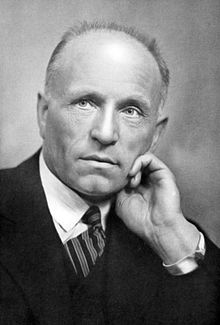Martin Tranmæl
Martin Tranmæl | |
|---|---|
 | |
| Born | 27 June 1879 Melhus, Norway |
| Died | 11 July 1967 (aged 88) |
| Nationality | Norwegian |
| Occupation | Politician |

Martin Olsen Tranmæl (27 June 1879 – 11 July 1967)[1][2][3] was a Norwegian socialist leader from The Norwegian Labour Party.
Biography
[edit]Martin Tranmæl grew up on a middle-sized farm in Melhus, in Sør-Trøndelag county, Norway. He started working as a painter and construction worker. In the early 20th century, Tranmæl lived for a while in the United States where he came into contact with the American workers movement, and even though he joined the AFL, he was also present at the founding congress of the Industrial Workers of the World, whose revolutionary syndicalist ideology he continued to be influenced by after returning to Norway.[4] Upon his return, he eventually joined Norwegian Labour Party where he soon became one of the main leaders of the Party's left wing and worked for many different socialist papers.
Tranmæl became a Communist after learning of the Russian Revolution of 1917, and he attended Comintern meetings in Russia and encouraged the Norwegian Labour Party to join the Communist International organization and accept the Twenty-one Conditions for membership. Eventually Tranmæl led the Norwegian Labour Party out of the Comintern after a conflict with its chairman Zinoviev in 1923. The Party was split in two and the Communist Party of Norway was formed that year by people who wanted to stay in the Comintern.
He participated in the Left Communist Youth League's military strike action of 1924. He agitated for it through the newspaper Arbeiderbladet, and was convicted for this crime and sentenced to 5 months days of prison.[5]
During World War II and the Nazi occupation of Norway, Tranmæl had to leave Norway and exiled in Stockholm, Sweden.[6] He had many friends there like Zeth Höglund and Ture Nerman. After the war he returned to Norway, and while still a socialist, had more moderate views and supported the Norwegian membership in NATO in 1949.
Selected works
[edit]- De faglige kampmidler og organisasjonsformer, (1911)
- Hvad fagopposisjonen vil, (1913)
- Hvem vil borgerkrig?, (1915)
- Socialisme og de socialistiske fremgangslinjer, (1918)
- Revolutionær fagbevægelse, (1920)
- Cellebetragtninger, (1922)
- Arbeiderungdom! Et alvorsord fra fengslet, arbeiderungdommen og kommunismen, (1925)
Sources
[edit]- Olsen, Bjorn Gunnar (1991) Tranmæl og hans menn
- Zachariassen, Aksel (1979) Martin Tranmæl
- Lie, Haakon (1988) Martin Tranmæl
References
[edit]- ^ Damslora, Svein. "Martin Tranmæl". In Bolstad, Erik (ed.). Store norske leksikon (in Norwegian). Retrieved 6 December 2019.
- ^ Steenstrup, Bjørn, ed. (1968). "Fortegnelse over personer som siste gang er omtalt i utgaven 1964 med angivelse av deres dødsdatum". Hvem er hvem? (in Norwegian). Oslo: Aschehoug. pp. 619–626.
- ^ Olsen, Bjørn Gunnar (1991). "Ved vandringens slutt". Tranmæl og hans menn (in Norwegian). Oslo: Aschehoug. p. 439. ISBN 82-03-15748-3.
- ^ Claesson, Alf (1981). Syndikalism förr och nu. Stockholm: Federativs förlag. pp. 24–25. ISBN 91-85016-77-2.
- ^ Per Maurseth (1987). Gjennom kriser til makt 1920-1935. Volume three of [Arbeiderbevegelsens historie i Norge (in Norwegian). Oslo: Tiden. p. 502. ISBN 82-10-02753-0.
- ^ Joachim Joesten (Autumn 1942). "The Lights went on". The Virginia Quarterly Review. 18 (4): 551. JSTOR 26448498.
External links
[edit]- Norwegian syndicalists
- 1879 births
- 1967 deaths
- Labour Party (Norway) politicians
- Norwegian communists
- Norwegian Comintern people
- Norwegian newspaper editors
- Norwegian temperance activists
- Members of the Executive of the Labour and Socialist International
- Norwegian prisoners and detainees
- Prisoners and detainees of Norway
- People from Melhus
- Syndicalists
- Dagsavisen editors
